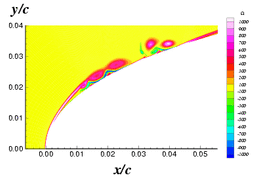
The objective of this work was to develop a fundamental understanding of the key physical phenomena taking place during dynamic stall, so that it may ultimately be controlled and, perhaps, exploited. Dynamic stall is the process by which vorticity is known to erupt suddenly from the leading edge of aerodynamic surfaces during unsteady motion or rapid maneuver. Once this vorticity is released, it tends to roll up into well-defined vortical structures which ultimately convect downstream, thereby creating rapid changes in the pressure distribution. These changes can induce variations in pitching moment which are detrimental, both for controlled maneuvering and because of excessive loading, e.g., on helicopter rotor blades.
In the first portion of this work, the approach used was based on a vorticity balance analysis about the leading edge of a two-dimensional airfoil. The analysis was based on the hypothesis that the cause of dynamic stall is linked to the disparate characteristic times for the various physical processes taking place. A key addition to these ideas came from numerical simulations showing that the transient value of the vorticity flux at short times is considerably larger than its steady-state value. To model these effects, the semi-analytical formalism of indicial theory was extended to characterize the dynamics of integrated vorticity fluxes and vorticity accumulation at the leading edge. It was shown that the flow response to large amplitude (from 10 to 15 degrees angle of attack) nonlinear motions can be predicted reasonably accurately, provided that the indicial functions of the flow are inferred in the Laplace domain and stretched to account for quasistatic nonlinearity.
In the second portion of this work, highly accurate, grid converged two-dimensional solutions of the Navier-Stokes equations were used on a model problem to investigate the Reynolds number scaling of incipient flow separation between chord Reynolds numbers of 50,000 and 800,000. This portion of the work was motivated by the suggestion that the appearance of reruptive plumes of vorticity at high Reynolds numbers might be critical to the formation of the dynamic stall vortex. The results of the research appear to contradict the hypothesis that a form of Reynolds number bifurcation must take place at some intermediate (high, laminar) Reynolds number. Instead, self-similar behavior was observed at least up to the time of formation of the primary stall vortex.
References:
- Reisenthel, P. H., "Towards a Semi-Analytic Tool for the Prediction of Dynamic Stall."
AIAA Paper 94-0537.
- Reisenthel, P. H. et al., "A Study of Reynolds Number Effects on Incipient Leading Edge Stall."
AIAA Paper 94-39.
 Further references
Further references





